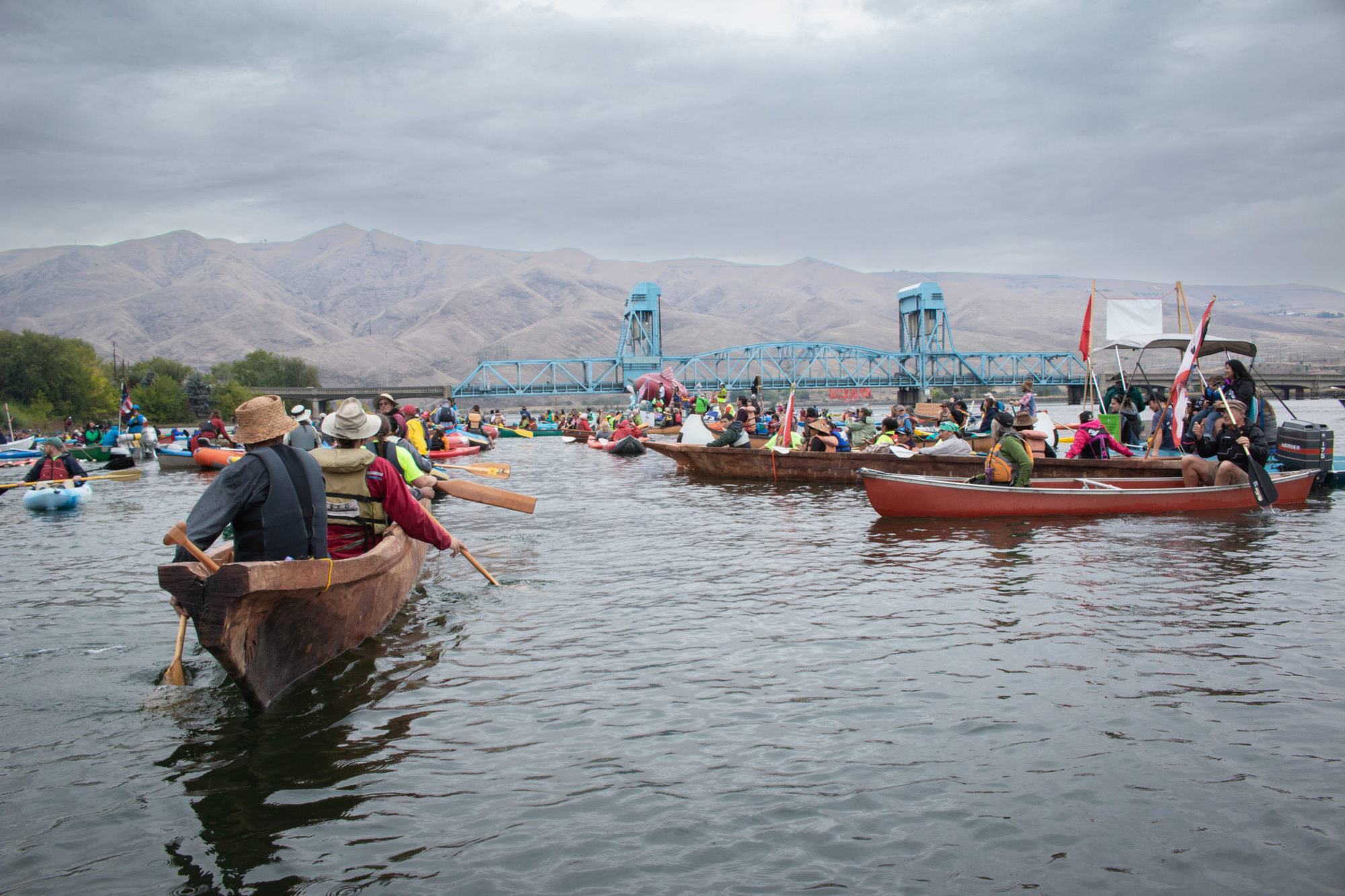
Proposal would exchange breaching dams for suspending bedrock environmental laws
We strongly support removal of the lower four Snake River dams to rebuild the wild salmon and steelhead populations they have harmed—for the fish, the orcas, and the people who depend on those fish. However, we do not support suspending the nation’s most important environmental laws for an entire generation across the vast expanse of the Columbia River Basin as part of a deal to breach these four dams. This proposed deal will not protect native species in the Columbia Basin. Rather, the proposed deal will put the entire region’s salmon and steelhead—along with numerous other species and human health—at great risk. We stand ready to work with those who recognize the need to remove the lower four Snake River Dams without sacrificing the nation’s most important environmental laws across the Columbia Basin.
Recently, Rep. Mike Simpson (R) Idaho released a “concept” proposing to breach (but not remove) the lower four Snake River dams. Breaching these dams, along with addressing the impacts of breaching, are needed and welcome, and we appreciate Rep. Simpson’s willingness to entertain this possibility.
However, missed in the understandable enthusiasm about this long-overdue recognition of the need to remove these dams is that Simpson’s Concept includes far more, including suspension of federal environmental laws, eliminating the federal role in the region’s science, and spending about 34 billion dollars across the Northwest for a variety of largely undefined projects. This Concept is rapidly moving towards being written into either the Infrastructure Bill expected in Summer 2021 or the next Budget Reconciliation measure that would be passed before the end of 2021.
The basic quid pro quo in the Simpson Concept is this: the lower four Snake River dams would be breached and, in return, essential national environmental laws would be suspended across the basin for a generation, along with buying off special interests. While still vague, the Concept is exceptionally broad in reach and stunning for its potential to adversely impact wild fish, wildlife, human health and the laws that protect them in the Columbia Basin. Here’s what you need to know.
The Simpson Concept, as written, proposes to:
→ Lock in the Status Quo for all Other Qualifying Dams and Hydropower Projects for up to 50 Years: The Concept would lock in ALL other public and private hydropower dams licensed by the Federal Energy Regulatory Commission (FERC) over 5 megawatts in the Columbia Basin in the U.S. with a 35-year license extension (up to 50 years total on the license). These dams harm salmon and steelhead and other aquatic and marine species, such as Puget Sound’s resident orcas that eat these salmon. Restoration of salmon to historic habitat would be severely compromised. Providing an automatic extension of FERC licenses would:
→ Waive Bedrock Federal Environmental Laws at These Dams for 35 Years: The Concept would suspend widely supported environmental laws at ALL of these dams with respect to anadromous fish for 35 years. Species, habitat, and water quality would no longer be protected by the Endangered Species Act (ESA), Clean Water Act (CWA), or National Environmental Policy Act (NEPA) at any such dams across the Columbia Basin. The Concept would stop all ongoing litigation for 35 years. The number of dams ensnared in this massive exemption from the nation’s environmental laws is approximately 82 in Oregon, Washington, Idaho, and Montana. This proposal, as we understand it:
→ Waive Bedrock Environmental Laws with Respect to Agriculture and Water for 25 Years: The Concept would allocate 3 billion dollars for “voluntary” agricultural watershed partnerships. Wherever a partnership is located—likely across the entire Columbia Basin that includes large parts of Idaho, Oregon, Washington, and Montana—the Concept exempts “agricultural interests” from the CWA and the ESA for 25 years with respect “to water issues in their basin.” Thus, the Concept would eliminate protections for rivers, streams, wetlands, aquifers, species and human health as follows:
→ Control Over Waters, Including Water Quality Protection, Would be Turned Over to State Agriculture Departments: The Concept would place these watershed partnerships and federal funding under the control of the state Departments of Agriculture in each state, thus:
→ Fails to Meaningfully Address Salmon-Killing Water Temperatures in the Mainstem Columbia River: Despite the rising water temperatures in the mainstem Columbia River, the Concept does nothing to reverse this existential threat to every basin salmon species that must traverse this migration corridor. The USEPA and other federal agencies have recognized the need to address these temperature impacts to salmon in a changing climate including by protecting cold-water refuges on the mainstem that rely on cooler tributary temperatures. The Concept would undermine and eliminate the best tools to address lethal water temperatures in the mainstem Columbia, including:
→ Invest in Infrastructure that Harms Salmon and Steelhead: Despite scientists’ recognition that hatcheries are one of the four major factors—habitat, hydropower, hatcheries, and harvest—that are causing the collapse of wild salmon and steelhead populations in the Columbia Basin, the Concept would pump hundreds of millions of dollars into basin hatcheries at the expense of the few remaining wild fish without any scientific, economic, or legal analysis of hatchery impacts. The Concept would also:
→ Spend 34 Billion Dollars with Little or No Accountability: The vast funds proposed in the Concept would pay for replacement energy for power generation lost from the four breached dams; a Bonneville Power Administration (BPA) bail-out from impending financial collapse; and various agricultural, infrastructure, energy, transportation, dredging, and other projects. The Concept lacks details about this proposed spending. In addition, the Concept:
The Viability of Salmon, Steelhead and Numerous Other Species Across the Columbia Basin, and Human Health Protection, Must Not be Bargaining Chips in the Negotiation to Remove the Lower Four Snake River Dams
Scientists identify at least 43 different runs of salmon and steelhead across the Columbia Basin that are at high or moderate risk of extinction or are of special concern. At least 63 other basin runs are already extinct. Four of the 13 most endangered runs in the basin use the Snake River. Measures tied to any deal to save these runs must not eliminate the possibility of survival and recovery for the dozens of other imperiled runs of salmon and steelhead across the Columbia River Basin. Likewise, numerous other aquatic species—orcas, frogs, salamanders, birds, freshwater mussels, as well as the people who drink water and eat the fish they catch in the Columbia Basin—depend upon cold, clean water and the protections of the nation’s environmental laws.
The undersigned agree that removal of the lower four Snake River dams is necessary. We support greater jurisdiction for the other sovereigns in the basin over salmon and steelhead and the operation of the hydropower system in the Pacific Northwest. We support science-based measures and investments that address and save imperiled salmon across the Columbia Basin. We support agriculture doing its part to protect public waters and imperiled species. However, the Concept, as written, despite the welcome acknowledgment of the need to remove the lower four Snake River dams, contains too many proposals that will accelerate the extinction of salmon and steelhead and other species in the Columbia Basin and harm human health.
We stand ready to work with those who recognize the need to remove the lower four Snake River dams and address related impacts of breaching these dams. However, we cannot support a proposal that sacrifices environmental laws, sacrifices the human health and species protections provided by those laws, spends billions without requiring benefits, and will likely accelerate the extinction of salmon and steelhead runs and other species across the Columbia Basin.
Signed,
Quinn (Quynh Dien) Read
Oregon Policy Director
Center for Biological Diversity
[email protected]
Nina Bell
Executive Director
Northwest Environmental Advocates
[email protected]
John DeVoe
Executive Director
WaterWatch of Oregon
[email protected]
Kurt Beardslee
Executive Director
Wild Fish Conservancy
[email protected]
Mark Sherwood
Executive Director
Native Fish Society
[email protected]
Pete Soverel and David Moskowitz
President and Executive Director
The Conservation Angler
[email protected]
Travis Williams
Executive Director
Willamette Riverkeeper
[email protected]
Greg McMillan
President
Deschutes River Alliance
[email protected]
Sarah Cloud
Executive Director
Deschutes River Alliance
[email protected]
Bethany Cotton
Conservation Director
Cascadia Wildlands
[email protected]
Ben Gordon
Executive Director
Central Oregon Landwatch
[email protected]
Paula Hood, Co-Director
Blue Mountains Biodiversity Project
[email protected]
Tarah Heinzen
Legal Director
Food & Water Watch
[email protected]
Sean Stevens
Executive Director
Oregon Wild
[email protected]
Amy van Saun
Senior Attorney
Center for Food Safety
[email protected]
Marlies Wierenga
Pacific Northwest Conservation Manager
Wild Earth Guardians
[email protected]
Friends of the Earth
Marcie Keever
Oceans & Vessels Program Director
[email protected]
Tim Judson
Executive Director
Nuclear Information and Resource Service
[email protected]
Ashley Chesser
Executive Director
Northwest Center for Alternatives to Pesticides
[email protected]
Re: Oppose Rep. Simpson’s Disastrous “Energy and Salmon Concept”
Sign on letter from 17 organizations to Senators Ron Wyden, Jeff Merkley, Patty Murray, and Maria Cantwell

Join our mailing list to recieve important updates on our work, the latest wild fish news, & opportunities to take action to support wild fish.
This site is protected by reCAPTCHA and the Google Privacy Policy and Terms of Service apply.
Wild Fish Conservancy is recognized as a 501(c)3 non-profit by the IRS